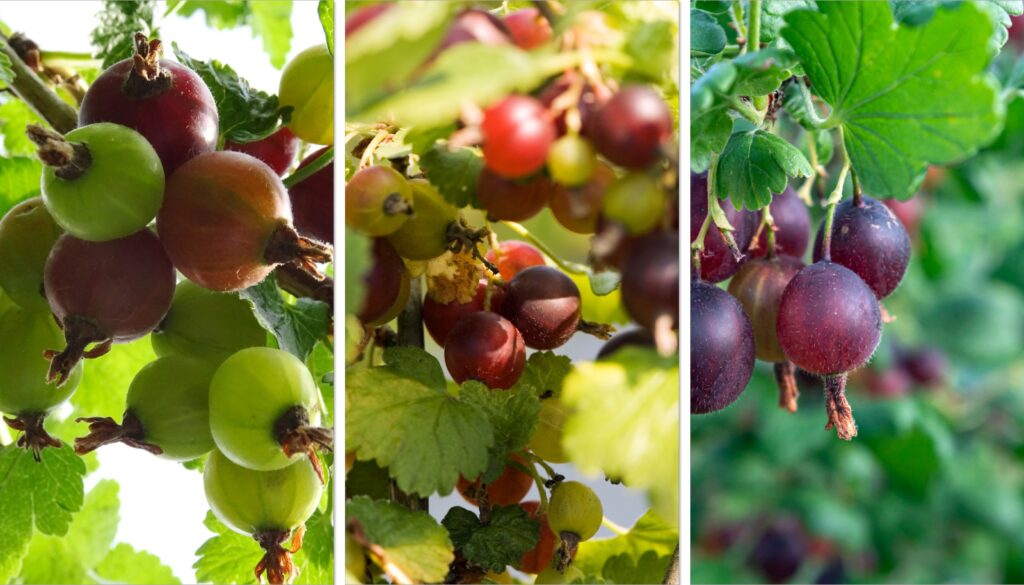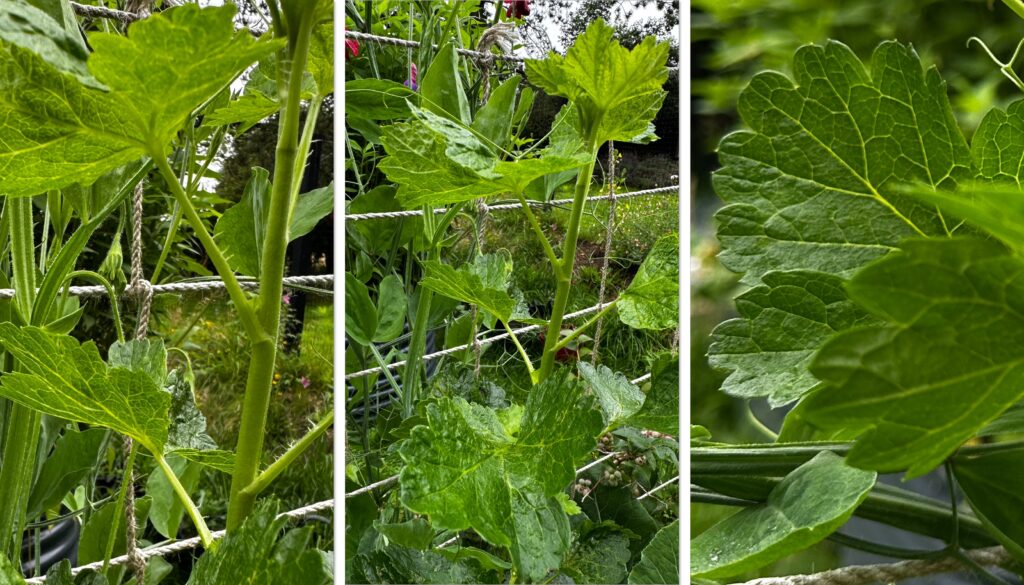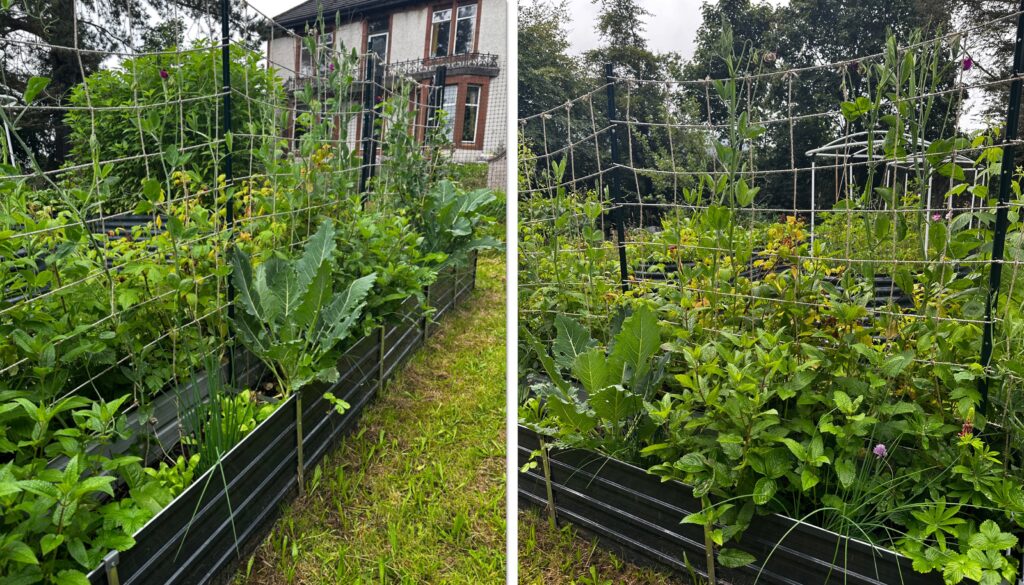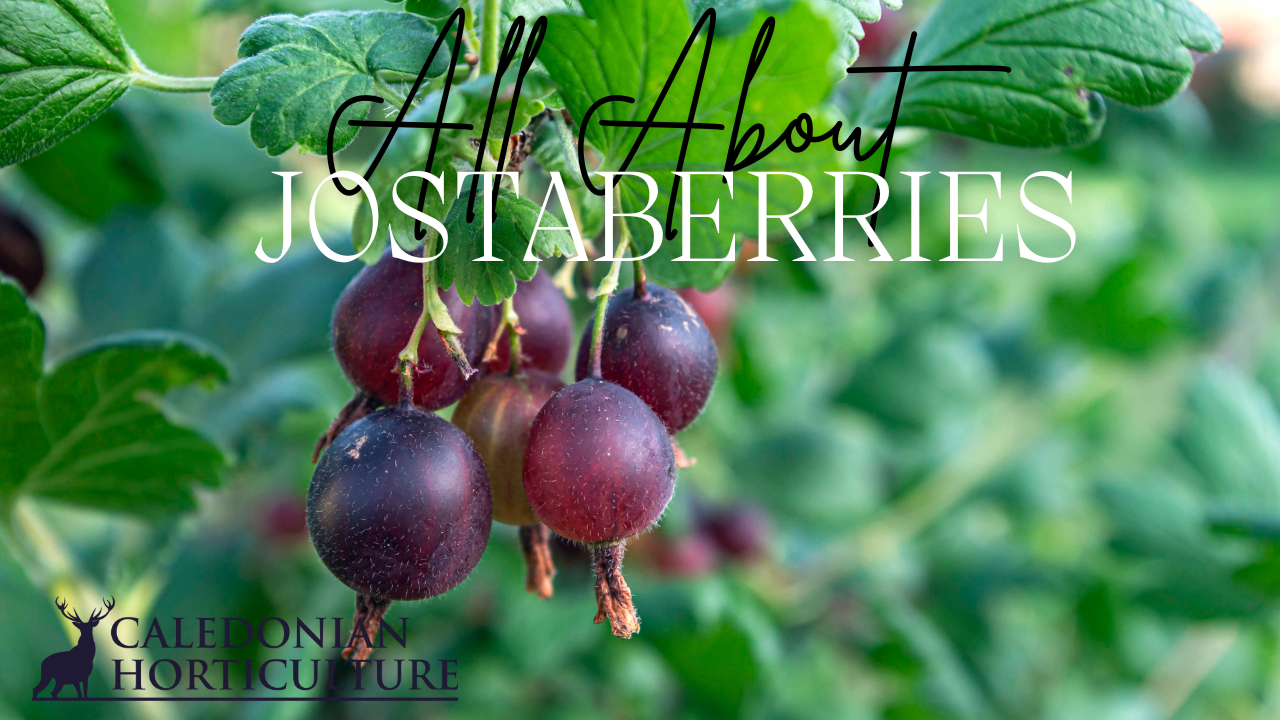Guest post blog by Katrina & Clayton
Jostaberries, a hybrid cross between blackcurrants and gooseberries, are a hardy and versatile fruit shrub that performs exceptionally well in Scotland’s temperate climate. They combine the vigour of gooseberries with the disease resistance and rich flavour of blackcurrants, making them an excellent choice for gardeners who want a reliable crop with minimal fuss. In Scotland, where cool summers, high humidity, and frequent rainfall are the norm, jostaberries thrive thanks to their tolerance for damp conditions and their resilience to frost.
These shrubs grow into vigorous, thornless bushes that can reach up to 2 metres in height and spread if left unpruned. They produce dark purple to almost black berries, which are slightly larger than blackcurrants and offer a tangy yet sweet flavour, perfect for jams, jellies, wines and eating fresh. With proper care, jostaberries can live and produce fruit for 12–15 years, making them a long term addition to any productive garden or allotment.
The berries can be eaten fresh, although they are often tart and may appeal more to those who enjoy sharper flavours. They are ideal for making jams, jellies, chutneys, pies, cordials, and even fruit wines.
Planting Jostaberries
For best results, plant jostaberries in late autumn or early spring, when the ground is workable but not frozen. These times allow the roots to establish before the growth demands of summer. Choose a sunny to partially shaded spot; while jostaberries tolerate light shade, full sun encourages stronger fruiting and sweeter berries—particularly important in northern regions where summers can be cool.
Prepare the planting area by clearing weeds and enriching the soil like Caledonian Green Goodness. Dig a hole large enough to comfortably accommodate the root system. Set bare root plants so that their crown sits about 5 cm deeper than they grew in the nursery, this encourages strong basal shoot growth. Space multiple bushes at least 1.5 metres apart to allow good airflow and reduce the risk of mildew, which can occur in Scotland’s damp summers.
After planting, water thoroughly and mulch generously around the base to help retain moisture and suppress weeds. Use organic mulch such as bark chips, straw, or compost, but keep it a few centimetres away from the main stems to prevent rot.

Pruning Jostaberries
Pruning is key to maintaining healthy, productive jostaberry bushes. They fruit mainly on wood that is one to three years old, so the goal is to keep a steady supply of younger shoots while removing older, less productive stems. In Scotland, pruning is best carried out during the dormant season, typically between late autumn and late winter, when the plant has lost its leaves.
Start by cutting out any dead, diseased, or damaged branches. Next, remove stems that are more than four years old, these can be identified by their darker, thicker appearance. Aim to maintain a well spaced framework of about 10–12 strong stems of varying ages. Thin out congested growth to improve light penetration and airflow, which helps reduce fungal issues common in humid climates.
In summer, light pruning can also be done to remove any low hanging branches that touch the soil. This prevents berries from rotting and makes harvesting easier. Consistent annual pruning not only encourages better yields but also keeps the bushes from becoming too large and unmanageable.
Propagating Jostaberries
Jostaberries, like other woody shrubs, are not divided in the same way as herbaceous perennials. Instead, they can be propagated through hardwood cuttings or by layering. Hardwood cuttings are the most effective method and can be taken in late autumn or winter when the plant is dormant.
To propagate via hardwood cuttings, select healthy one year old shoots about 20–25 cm long. Cut just below a bud at the base and above a bud at the top. Insert these cuttings into prepared soil beds or pots filled with a mix of garden soil and compost, leaving about a third of each cutting above ground. Keep the soil moist over winter, and by spring, roots should begin to form. These young plants can be transplanted to their final positions after a year.
Layering is another low effort technique. In early spring, bend a flexible stem to ground level, bury part of it in soil while leaving the tip exposed, and secure it with a peg or stone. By autumn, roots will have formed along the buried section, allowing you to cut it from the parent and replant it as an independent shrub.

Caring for Jostaberries
Jostaberries are relatively low maintenance but benefit from consistent care to achieve the best yields. Water regularly during dry spells, particularly in the first few years while the root system establishes. Once mature, they tolerate short dry periods but still perform best in consistently moist soils.
Weed control is essential, especially around the base, as weeds compete for nutrients and water. Because jostaberries are thornless, they are easy to net, which is often necessary in Scotland to protect ripening fruit from birds, particularly blackbirds and pigeons.
Companion Planting with Jostaberries
Jostaberries benefit from companion planting that helps conserve soil moisture, deter pests, and increase pollinator activity. Suitable companions include herbs such as chives, which can deter aphids, and flowers like marigolds, which attract beneficial insects. Low growing ground covers such as strawberries or clover can help suppress weeds and protect the soil without competing too heavily for nutrients.
Avoid planting jostaberries near members of the solanaceae family (tomatoes, potatoes, etc.), as they can harbour similar fungal diseases like blight. Similarly, give them adequate space away from other heavy feeding fruit bushes to prevent nutrient competition.

What Soil is Best for Jostaberries
Jostaberries thrive in fertile, moist but well drained soil with a pH between 6.0 and 6.5, which aligns well with the slightly acidic to neutral soils commonly found in much of Scotland. Heavy clay soils can be suitable if improved with organic matter to enhance structure and drainage. On sandy soils, adding compost or leaf mould helps retain moisture and nutrients.
These shrubs dislike waterlogging, which can lead to root rot, so avoid planting in low lying areas prone to standing water. If drainage is poor, consider creating raised beds. Mulching annually with compost improves soil texture, feeds the plant, and supports healthy microbial activity.
In addition to being easy to grow, jostaberries provide a versatile fruit that can be enjoyed fresh or preserved in a variety of ways.
Katrina & Clayton

Katrina & Clayton live with their family in East Ayrshire in Scotland and share their daily life in the garden on instagram @buildingfoodforest_scotland. They practice permaculture principles, reducing & repurposing waste whenever they can. Katrina shows how home educating in nature has helped Clayton thrive.
Clayton Completed The Grow and Learn Course with the Royal Caledonian Horticultural Society in 2022. This year he will be completing Level 2 Nurture Course. Clayton is 16, Autistic, Non Verbal & has been Home Educated for the last 6yrs. Both Katrina and husband Peter have studied the Permaculture Design Course PDC and PDC Pro over the last 5yrs, developing their garden from grass to an ongoing food forest.
They have featured on BBC Beechgrove Gardens, Gardeners World Magazine and write for Scotland Grows Magazine. Katrina has a series of children’s story books out following the life of Clayton in the garden. Available at Amazon.
See more and follow Katrina & Clayton at the links below:
-
 Builder’s Bag Planter Mix£79.00 inc VATRated 4.93 out of 5 based on 43 customer ratings
Builder’s Bag Planter Mix£79.00 inc VATRated 4.93 out of 5 based on 43 customer ratings -
 Builder’s Bag Kelpie Compost£72.00 inc VATRated 4.96 out of 5 based on 138 customer ratings
Builder’s Bag Kelpie Compost£72.00 inc VATRated 4.96 out of 5 based on 138 customer ratings -
 Builder’s Bag Green Goodness£52.00 inc VATRated 4.90 out of 5 based on 199 customer ratings
Builder’s Bag Green Goodness£52.00 inc VATRated 4.90 out of 5 based on 199 customer ratings



